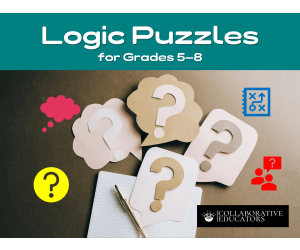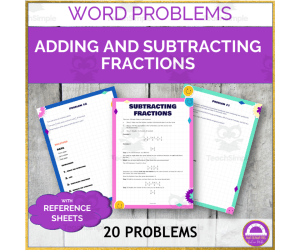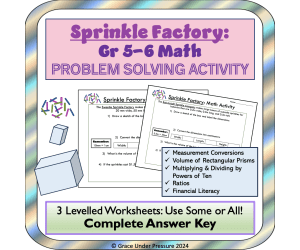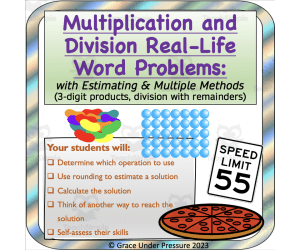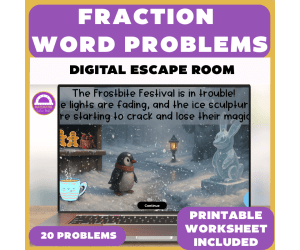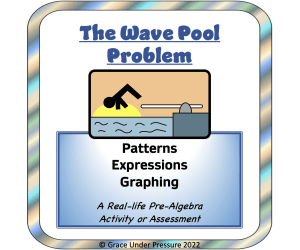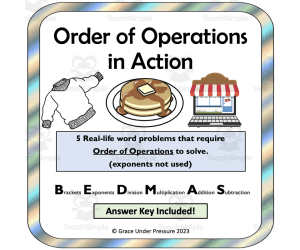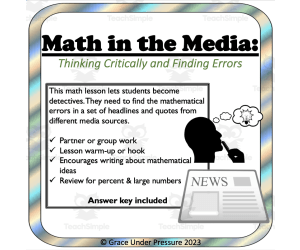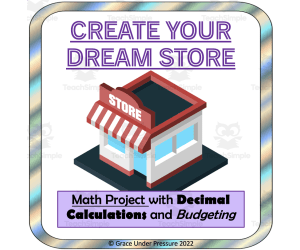2,796 products added recently
6th Grade Word Problems
Support sixth graders with word problems involving ratios, proportions, and introductory algebra. These worksheets promote higher-level thinking and real-world application. Incorporate them to strengthen mathematical reasoning.
Winter Unit Rates Word Problems Digital Escape Room
Math, Fractions, Winter, Seasons, Holiday & Seasonal, Grade 5, 6, 7, Escape Room, Activities, Worksheets & Printables, Word Problems, Worksheets
If your students struggle with unit rates, this Winter Digital Escape Room will give them the practice they need without the struggle. Rather than slog through another page of word problems, students are placed into a scenario where unit rate problems are a necessary part of bringing back the Frostbite Festival. This allows enough purpose to be added to avoid taking away from the math. Students work through twenty actual-unit-rate word problems set in four escape room winter scenes: The Snack Shack, Skating Trail, Yeti Workshop, and Penguin Performance. Students work with word problems related to cost, distance, time, and quantity from the everyday experience they realize from using unit rates. In order to progress, students must compute the correct answer and type it into the escape room. The escape room is a completely self-contained activity, which means students will not be able to progress with an incorrect answer, making this activity perfect for independent practice. One of the most beneficial aspects of this resource is the low level of work that it generates. There is no prep work that is necessary. You don’t have to set up anything, including logins and passwords and lock screens. You can just send out the link via Google Classroom, Canvas, Schoology, Microsoft Teams, or whatever tool that you are using. They just click and start. This autosave functionality comes in very handy during longer class times or interruptions. So long as students have had the chance to log back into the same computer and browser, they will pick up exactly where they left off. To make it more flexible, a printable version is also included. You will get a worksheet featuring all twenty unit rate problems, a matching version task card set, and finally, a full answer key. This is perfect for math center activities, small-scale intervention groups, or homework. Both the student and teacher instructions are provided and WrittenClearly, so there’s no misunderstanding or guestimation of how to do things. Students know just how to input their answers, and teachers know how to assign and use the autosave function. The skills which will be developed here include the understanding of the interpretation of unit rates, calculating a unit rate from a ratio, and using the rate in practical applications of money, time, distance, and measure problems. A winter unit rate resource that is engaging, organized, and actually easy to implement is not easy to find, but this escape room resource certainly delivers all of these things. Such a resource keeps students on task and provides a reliable no-prep resource for you to implement repeatedly.
Author Matemaths
Rating
Tags Mtemaths, Winter, Word Problems, Task Cards, Worksheet, Digital, Printable, Unit Rates, Escape Room
20 Logic Puzzles for Grades 5-8
STEM, Math, Science, Grade 5, 6, 7, 8, Games, Activities, Quizzes and Tests, Teacher Tools, Quizzes, Word Problems, Worksheets & Printables
Unlocking Logic: 20 Engaging Puzzles for Grades 5–8 is an entertaining and difficult set of brainteasers created to help middle school students improve their reasoning, critical thinking, and problem-solving abilities. There are 20 different puzzles in this ebook, such as logic grids, magic squares, numerical patterns, riddles, code-breaking, spatial thinking, and more. Every puzzle is designed to pique students' interest and promote original thought, which makes it ideal for early finishers, homework, enrichment, and classroom use. In order to engage a diverse variety of learners and facilitate flexible use across grades 5–8, the puzzles vary in difficulty and style. Pupils are urged to work alone or in groups, experiment with different approaches, and develop resilience by tackling problems carefully. To facilitate guided conversation and self-checking, a complete answer key is supplied. Whether you're a teacher looking to inspire your class or a parent wanting to support logical thinking at home, this ebook is the perfect companion for building sharp minds—one puzzle at a time!
Author Bright Classroom Ideas Marketplace
Rating
Tags Riddle, Logic, Puzzle, Quiz, Grade 5
Percent Word Problems: Tipping & Gratuities- Real World Math Worksheet
Life Studies, Home Economics, Special Resources, Life Skills, Math, Multiplication, Multiplication and Division, Percentages, Money, Grade 6, 7, 8, 9, Worksheets & Printables, Word Problems, Teacher Tools, Lesson Plans
Tipping is becoming more and more common and the amount you are expected to tip is increasing too. Make sure your students understand what tipping is and how to calculate a tip- useful life skills! Here’s a ready-to-print real-life percent math lesson for middle school students (in grades 6-9) or special education or life skills classes in a high school setting. Teach your class all about tipping culture and tips in both Canada and the United States. Why do people tip or give certain people a gratuity? What places do we tip? What places do we not? Has tipping been increasing recently ("tip-flation")? Show students how the math skills and concepts that they have been learning in class (percentages, decimals, division, fractions) can be useful in their everyday lives! How to Use: 1. The first page is a handout that you complete with your students (with fill-in-the-blanks) to teach them the ins and outs of tipping: where and when you do it, etc. 2. The second page teaches students two simple methods of calculating tips (using well-known percentage benchmarks OR multiplying the price by a percentage written in decimal form). Encourage your students to determine a third method they could use. 3. After that, there are 7 practice word problems of realistic tipping situations that your students can complete. From tipping for a meal to paying at a salon, or even calculating tax AND tip together, your students will get a lot of real-life practice completing these problems in small groups or own their own. 4. To finish, you can have a class discussion about tipping in general and what your students think about our system. What's Included: 6 Page PDF - Teacher Instructions - Handout with Fill-in-the-Blanks about Tipping - 3-Page Worksheet and Written Reflection - COMPLETE ANSWER KEY INCLUDED If you want more practice working with tips try these two products: Fractions for Calculating Taxes, Tips and Sales Percents for Calculating Taxes, Tips, and Sales
Author Grace Under Pressure
Tags Percent Word Problems, Tip, Tipping, Gratuity, How To Tip, How To Calculate A Tip, Financial Literacy, Life Skills, Personal Finance, Word Problems
6th Grade Math: Expressions and Equations Bundle: 7 Activities
Math, Graphing, Multiplication and Division, Division, Numbers, Algebra, Money, Grade 5, 6, 7, Worksheets & Printables, Word Problems, Activities
Do you need some new ideas for your 6th grade math unit to meet the Common Core State Standards for Expressions and Equations? Here is a ready-to-go bundle with seven fun real-life activities to incorporate into your unit plan. 1) Exponent Board Game: Students won't even notice how many exponent math problems they actually solve while racing their friends around this game board. 2) 5 Stations for Early Algebra: These fun stations allow students to solve word problems, play an expression game, create a growing pattern with counters, solve one-step equations, graph a pattern, and more! 3) Equivalent Expressions: Real-Life Financial Situations: Students write simple expressions for real-life situations, then use one of four strategies (from the provided handout) to convert them to equivalent expressions. A matching activity is also included! 4) Modelling Equations Using Visual Balance Scales: Here's a fun visual activity to teach your students about doing the same thing to each side of an equation! 5) The Wave Pool Problem: Students have to create tables of values, figure out an expression, graph two options, and decide which way they would prefer to pay to visit a new wave pool in their neighbourhood. 6) Inequality Matching Game: Here's a fun, whole-class matching game to practice solving simple inequalities! 7) Hockey Math Equations: Students complete tables and graph independent and dependent variables while exploring all the math found at a hockey arena. Grades to Use With: This bundle is designed for students in Grade 6, but can be used for Grade 5 enrichment, Grade 7 or 8 review, or high school special education classes. What's Included: 32 Page PDF with 7 Activities and complete answer keys! If you like this product, check out my other 6th Grade Math Bundles for each learning strand: 6th Grade Math Statistics and Probability Bundle 6th Grade Math Ratio and Proportional Relationships Bundle 6th Grade Math Number System Bundle 6th Grade Math: Geometry
Author Grace Under Pressure
Tags 6th Grade Math, Grade 6 Math, Algebra, Financial Literacy, Inequalities, Equations, Equivalent Expressions, Tables And Graphs, Expressions, Variables
Financial Literacy: My Party Budget- Decimals and Percentages Application
Life Studies, Finance, Home Economics, Math, Percentages, Decimals, Grade 5, 6, 7, 8, Worksheets & Printables, Word Problems, Activities, Projects
Financial Literacy: My Party Budget- Decimals and Percentages Application Unlock mathematics’ real-world influence with this practical math project for students in grades 5-8. This tool allows students to sharpen their intermediate math skills, particularly applying percentage calculations and decimal operations to manage a budget consciously - a vital lesson in financial literacy. This versatile resource is ideal for grades 5 to 8 classrooms as well as high school special education environments where budgeting practice complements life skills training. How to Use: Give each student a party budget. You can choose to give everyone the same budget, OR this is a great way to differentiate. Give students with emerging understanding a budget of $100 (which is easy to work with) and give students who need a challenge a budget such as $240, which will result in more complex calculations. This will also stimulate discussions about budgeting in general and the challenge of planning with less money. Students need to partition their hypothetical party budget across varied cost categories like food, decorations and entertainment by employing basic percent in decimal form and understanding addition and multiplication of decimals. For example, they might decide to spend 50% of their budget on food because that is their favourite part of a party. They will calculate 50% of their total budget. This skill application brings relevance to numbers through experiential learning. You can decide if students should complete calculations by hand or if using a calculator is allowed. Also, a complete sample answer key is included that you can show to your students to demonstrate the task. Finally, students complete shopping research and choose items online or in store flyers. This fosters strategic thinking when managing limited resources. You can have a discussion about making tradeoffs (for example, choosing frozen pizza instead of fresh to have extra money for a party activity OR inviting fewer guests to have more money for party favours per person). What's Included: A total of 8 pages in PDF Format Title Page Teacher Instructions 3 Page Student Worksheets 3 Page Sample Answer Key
Author Grace Under Pressure
Tags Financial Literacy, Decimals, Percentages, Budgeting, Math Application, Budget, Real World Math, Math Project, Applied Math, Party Project
Statistics Word Problems: Compare Two Data Sets of Annual Salaries
Math, Graphing, Measurements, Statistics, Grade 6, 7, 8, Worksheets & Printables, Worksheets, Word Problems
This middle school math lesson allows your students in grades 6-8 to apply the statistical skills they have been learning in class to a real-world financial literacy scenario: the annual salaries of workers who have a college degree compared to those who do not have one. It is a real world math activity that includes five worksheets all ready to go! Your students will: - Make two dot plots to display two data sets (that are included with the lesson): wages for people with a college degree and those without - Share observations about the distribution of data in each set - Calculate the mean, median and interquartile range for each data set - Draw inferences about whether there is an effect of a college education on someone's annual salary - Consider if the sample that was used is representative This lesson was designed to specifically address 7th Grade Common Core Math Standards for the Statistics and Probability strand: 7.SP.A.1 7.SP.B.3 7.SP.B.4 What's Included: 7 Page PDF- Ready to Print and Use! - Title Page with Teacher Instructions - Student Handout that has Two Data Sets (with 20 items each) - Dot Plot Worksheet (for students to graph and compare two dot plots) - 2-Page Measures of Central Tendency and Variation Worksheet - Reflection Worksheet - Answer Key If you enjoy this statistics lesson, check out other fun options in my store: Middle School Math Stations or Centers for Statistics and Probability: 5 Math Centers that are a great way to prepare for a unit test! Create Dot Plots and Histograms: 6th Grade Statistics and Graphing Practice: Students create and carry out their own survey and then graph it two ways! Identifying and Writing Statistical Questions for 6th Grade Math: Help your students learn ways to collect data and try it out!
Author Grace Under Pressure
Tags Statistics, Compare Data Sets, Financial Literacy, Dot Plots, Statistics Word Problems, Compare Data Distributions, Mean, Median, Interquartile Range, Graphing Data
Multi Step Word Problems | Adding and Subtracting Fractions
Math, Fractions, Grade 5, 6, 7, Word Problems, Worksheets & Printables
This comprehensive no-prep tool is designed to make the complexities of working with fractions easy for your students. To make your teaching and your students' learning easy, this resource comes complete with a two-page reference sheet that serves as a quick review on adding and subtracting fractions. Whether your students need a refresher or an initial understanding, this reference sheet is a valuable help. Each problem in this set is carefully crafted to challenge and engage students, providing real-world scenarios that require the application of adding and subtracting fractions with unlike denominators. But what truly makes this resource more valuable is the inclusion of detailed, step-by-step solutions for every problem. This feature ensures that students not only tackle the problems but also understand the underlying concepts. No more confusion or uncertainty – this resource empowers your students to grasp these fundamental mathematical principles with confidence. This resource is a great addition to your teaching arsenal and can be used effectively in various scenarios, making it perfect for: Morning Work: Kickstart your students' day with engaging multistep word problems that foster critical thinking and mathematical skills. Homework: Reinforce learning outside the classroom by assigning these problems as homework, allowing students to practice and consolidate their knowledge. Small Groups or Large Group Instructions: Adapt the resource to your class size and teaching style, whether it's a collaborative small group activity or a whole-class instruction. Early Finishers: Keep your fast-paced learners challenged and occupied with these enriching problems that promote mathematical thinking. Emergency Sub Plan: Ensure uninterrupted learning even when you have a substitute teacher by having this resource ready to go. This resource empowers both teachers and students with the tools needed to learn these essential mathematical concepts. Make learning fractions an engaging and rewarding experience, and watch your students thrive in their mathematical journey.
Author Matemaths
Tags Matemaths, Worksheet, Fractions, Word Problems
Volume Word Problems: Sprinkle Factory Grade 5 & 6 Conversions, Ratios
Math, Measurements, Multiplication and Division, Geometry, Grade 5, 6, Worksheets & Printables, Word Problems
Here’s an engaging 5th grade or 6th grade differentiated problem solving worksheet that includes several real-world math skills: o Conversions of standard measurements: millimetres to centimetres and centimetres to metres (5th Grade Measurement) o Calculating the volume of a rectangular prism that has whole number side lengths (5th Grade Measurement) o Multiplying & dividing by powers of ten (5th Grade Numbers in Base Ten) o Simple financial literacy (comparing prices) o Ratios and Rates (6th Grade Ratios and Proportional Relationships) Students will work on a realistic scenario: measuring boxes of sprinkles made at the sprinkle factory. Some are small for home use, and some are much larger for bakery and industrial applications. They will complete the following tasks for each box: Sketch the sprinkle box shape in 3-D with labelled measurements Complete simple and guided unit conversions on the measurements Calculate the exact volume of each box in centimetres cubed Determine the prices of each box using simple rates. This activity included three levels of difficulty: you can assign differing amounts to easily differentiate for your students, or complete the whole activity as a class, step-by-step. Level 1) Involves converting millimetres to centimetres and calculating the price and volume of the small box of sprinkles. Level 2) Has students convert metres to centimetres and calculate the volume and price of the larger box of sprinkles. Level 3) Students will compare the prices of the different boxes to find out which is a better deal using simple rates. This is an open-ended question, and there are lots of ways for students to solve it. You can have different students share their personal strategies with the rest of the class for further learning. What's Included: A 5-Page PDF that is ready for you to print Teacher instructions 3 Differentiated Student Worksheets A Complete Answer Key
Author Grace Under Pressure
Tags Word Problems, Volume Of Cubes, Ratios, Unit Conversions, Grade 6 Word Problems, Grade 5 Word Problems, 6th Grade Word Problems, 5th Grade Word Problems, Real World Math
Real-Life Long Division Word Problems and Multiplication Word Problems
Math, Multiplication and Division, Multiplication, Division, Grade 4, 5, 6, Worksheets & Printables, Word Problems, Activities, Worksheets
In this math lesson, your students will Learn the definitions of multiplication, division, and estimating Determine which operation to use (multiplication or division) to solve a real-life word problem Use rounding and benchmarks to estimate a solution Calculate the solution with the standard algorithm Think of another way to reach the solution Self-assess their skill Grades to Use With: This lesson is designed for students in grades 4-6 who are learning and/or practicing their multiplication and division skills using the standard algorithm AND a variety of other estimating and benchmark methods. It includes three-digit products, one-digit divisors, and division with remainders. How to Use: Go over the first page together as a class. Review the definitions of multiplication, division, and estimating. Then complete the first word problem together- modelling the 4 steps: choose the operation, estimate, solve, and solve using an alternate method. Then you can let students work on the five other problems independently or in small groups. They could do some of the problems in class and a couple of them for homework. I have included a quick self- assessment at the end, so you can see which steps students are confident with and which are a bit more challenging. My students often struggle to think of an alternate method to solve the problem, so I can target some small group support for that skill. What's Included: 6 Page PDF Title Page Student Definitions and Sample 3 Pages of Student Questions and Self- Assessment Answer Key If you enjoy this real-world math activity, check out others in my store: Create Your Dream Store with Math Calculations and Budgeting Grocery Game: Working with Decimals (Estimating, Multiplying, and Adding) Real-Life Math Assessment for a Line Graph Unit: Scale, Interpreting, and Graphing Data Gingerbread Math: Fractions, Decimals, and Percentages Using Tenths Financial Literacy: My Budget Project Math Project: Circle Graphs and Pie Charts
Author Grace Under Pressure
Tags Multiplication, Division, Word Problems, 5th Grade Math, 4th Grade Math, 6th Grade Math, Estimating, Multiple Methods, Long Division Word Problems, Multiplication Word Problems
Percent Word Problems: Calculating Taxes, Tips, Sale Prices Worksheets
Special Resources, Life Studies, Life Skills, Math, Percentages, Decimals, Money, Fractions, Finance, Home Economics, Grade 6, 7, 8, 9, Worksheets & Printables, Word Problems, Worksheets
Percent Math Lesson: Calculating Taxes, Tips, and Sale Prices Here's a ready-to-go lesson for your middle school math unit on percentages. It encourages students to use multiple methods and mental math when calculating the tax, tip, or sale price for everyday transactions. This is one of the times you can easily say to your students, "You will use this math regularly in your life!" How to Use: Start with the handout, which goes through three simple methods for calculating percentages. Benchmark: An easy calculation strategy using familiar percentages like 1%, 10%, and 50%. Decimals: Calculating involves multiplying the amount by its matching decimal form percentage. Fractions: Division based on fraction equivalents is used for identifying certain percentage amounts. Tell your students that certain methods work best for certain situations. For example, the fraction method is great for 50% or 25% off. The benchmark method is easy when calculating a 10% tip. The decimal method works great for calculating 12% tax. Next, students have six real world math problems to tackle involving taxes, tips, and sale prices. They can use any of the strategies to solve any of the problems- they should choose the one that is the easiest to use for each scenario! Students can work individually or in pairs or small groups collaboratively. Grades to Use With: This lesson is perfect for grade 7 classes that are working on Proportional Relationships to solve multistep problems. It could also be used for enrichment in grade 6 or for a review and lesson about multiple strategies in grades 8 and 9. Finally, it could be used in high school special education classrooms. What's Included: Ready-to-print 5 Page PDF with a title page, handout, 2 pages of practice questions, and a complete answer key! If you like this percentage activity, check out others in my store: Math Stations: Percent, Decimals and Fractions Visual Math: Percentages, Decimals, Ratios and Fractions Posters Grocery Store Shopping: Price Comparisons
Author Grace Under Pressure
Tags Percent Calculations, Real-world Math, Percentages, Financial Literacy, Mental Math, Fractions, Decimals, Budget, Percent, Percent Word Problems
Decimal Operations Assessment: Add, Subtract, Multiply, Divide
Math, Addition and Subtraction, Addition, Decimals, Multiplication and Division, Multiplication, Division, Subtraction, Grade 5, 6, 7, 8, Worksheets & Printables, Word Problems, Teacher Tools, Assessments
Decimal Operations Assessment : Add, Subtract, Multiply, Divide (with answer key) Do you need a quick and valid assessment for your decimal operations unit? Do you want to encourage your students to estimate before they calculate? Here is the math quiz for you! This 2-page decimal operations math quiz assesses the following topics Addition of decimals Subtraction of decimals Multiplication of decimals Division of decimals How to Use: The first page requires students not only to complete computations, but also to estimate their solutions before starting out. Half of the marks are given for successful estimations. This encourages students to develop estimation skills which can greatly help in identifying potential calculation errors. The second page contains word problems (worth 10 marks) that increase in complexity. These cover real-world scenarios such as unit price computation, tax calculations, evaluating sale prices and dealing with multiple operations simultaneously. These word problems aim to assess deeper levels of comprehension and application of decimal operation skills. What's Included: 5 Page PDF ready to print! Teacher Instructions 2 page decimal operations quiz 2 page complete answer key for easy marking Grades to Use With: This math quiz is designed for students in grades 5-8 who are first learning about decimal operations or reviewing this skill. The word problems also tie in with grade 6 learning standards about unit rates. This activity could also be used in high school special education classes. If you enjoy this applied math activity, check out others in my store: Grocery Game: Estimating, Adding, Multiplying Decimals Grocery Shopping Price Comparisons: Financial Literacy and Money Math Wave Pool Problem: Pre-Algebra Skills: Expressions, Tables, and Graphs: Real-Life Application Butter Tart Recipe Activity: Multiplication and Addition of Mixed Numbers and Improper Fractions Gingerbread Math: Decimals, Fractions, and Percentages Using Tenths Equivalent Fractions Practice in a set of 5 Stations or Centers
Author Grace Under Pressure
Tags Decimal Operations, Assessment, Problem Solving, Estimating, Multiplying Decimals, Adding Decimals, Math Quiz, Decimal Quiz, Decimal Operations Quiz, Unit Rate
Fraction Word Problems Digital Escape Room
Math, Fractions, Winter, Seasons, Holiday & Seasonal, Grade 5, 6, 7, Escape Room, Activities, Worksheets & Printables, Word Problems, Worksheets
Fraction problems on paper usually go over like a, well, snowball with your students; but this Winter Digital Escape Room changes that right away! Instead of plowing through problems on a page, students find themselves right in the middle of a wintery story in which their math smarts make all the difference. Their task? Unfreeze the Frostbite Festival with fraction problems embedded in four story scenarios. Students solve twenty fraction problems involving adding, subtracting, multiplying, and dividing fractions. With each correct solution giving the student a further piece of the puzzle and therefore the incentive to take their time and think before responding, this activity strongly encourages the student to take their time and think before responding. This activity also helps the student work independently without the need for constant checks by the teacher since the activity is entirely self-checking. The advantage: flexibility to perform calculations as improper fractions or as mixed numbers. This eliminates unnecessary frustration and “but my answer is right too” arguments among students. Then there is the autosave feature that allows students to save their work midway through the lesson, as long as they are on the same computer or accessing the page on the same web browser. There are also four winter-themed scenarios to keep things new and interesting throughout. Students will move around different activity cards of Snack Shack, Skating Trail, Yeti Workshop, and Penguin Performance. It is completely engaging and provides meaning without being distracting, which is exactly what you need when you are in the review session. This resource is the real deal in the realm of ‘no prep’ products. There is no account that needs to be set up, no passwords, and no complex installation. You simply share the link from Google Classroom, Canvas, Schoology, or whatever platform you use, and the kids can start working. It is completely seamless from the perspective of the users, including chromebooks, laptops, desktops, and tablets. In instances when you would prefer paper options or if you desire to reuse the problems in another manner, a complete printable version is also included. You'll get a worksheet with all the problems, a set of task cards to match the problems, and an answer key. Clear directions for both teachers and students are provided, and all can see exactly what the activity entails. Topics covered for both math and reading consist of all four fraction operations with unlike denominators and real-world fraction word problems. If you are searching for a winter fractions review that is engaging, organized, and easy to facilitate, this digital escape room meets every requirement and your students will want to solve it.
Author Matemaths
Rating
Tags Mtemaths, Fractions, Winter, Word Problems, Task Cards, Worksheet, Digital, Printable
Pre-Algebra Problem: The Wave Pool (Expressions, Tables, and Graphs)
Math, Algebra, Graphing, Grade 5, 6, 7, Worksheets & Printables, Word Problems, Worksheets
This lesson is an excellent addition to a pre-algebra unit in grades 6 or 7 to help show students a real-world application of using expressions, tables of values, and graphing to solve a simple, everyday financial literacy decision. Students are tasked with deciding how to pay to visit a new wave pool in the neighbourhood. They can pay a flat monthly fee or pay a smaller fee and then pay a small amount each time they go. The trick will be determining how often they are likely to go each month. Students get to: Analyze a realistic scenario Complete two tables of values Write a pattern rule in words and turn it into an expression with a variable Create a simple line graph to compare the two options visually Explain their decision in words using evidence from their mathematical work This lesson can be used in various ways: it can be used during full-class instruction or smaller group activities. It could be regular classwork, a homework assignment, or even a summative assessment. I liked to have students complete it near the end of our algebra unit to assess skills before the unit test and to have as an artifact for parent-teacher conferences. An extension challenge is offered that is specifically designed for early finishers. A complete answer key is also included for easy marking out of twenty points. Grades to Use With: This lesson is designed for upper elementary or middle school students in grades 5-7. It could also be used in high school special education classrooms. What's Included: 7 Page PDF with three page student assignment, title page, and complete answer key. If you enjoy this algebra activity , check out others in my store: Modelling Equations: Visual Balance Scales Independent and Dependent Variables in Grade 6 Math: Hockey Math Solving Systems of Equations Using Substitution Inequality Matching Game Exponent Board Game Writing and Solving Two-Step Equations
Author Grace Under Pressure
Tags Wave Pool, Pre-algebra, Expressions, Tables Of Values, Graphing, Graphs, Algebra, Variables, Real World Math, Word Problems
Addition and Multiplication of Mixed Numbers and Improper Fractions with Doubling a Recipe
Math, Fractions, Grade 4, 5, 6, 7, Worksheets & Printables, Word Problems, Activities
Butter Tart Recipe (based on my grandma's actual delicious family recipe!) Here is a real-life example to help students practice adding and multiplying mixed numbers and improper fractions. When students ask, "When will we ever use this in real-life?!" you can show them this lesson and say that working with fractions is so common in baking. This delicious activity will allow students to practice using fractions with a realistic everyday example: baking! Students will take a recipe that has several fractions in it and double it. Half a cup of something becomes a cup and 3/4 of a cup becomes 1 and a half cups. After that, they need to figure out how much of each ingredient would be needed if the recipe was made five times bigger (perhaps in a bakery setting or for a large event). I encourage my students to use different strategies to complete this task: drawing pictures with squares, repeated addition, or multiplication. Boxes for diagrams and math calculations are included to encourage students to show their work. You could even have different students come up to show their personal strategies to the rest of the class. As an extension, students can bring in their own recipes from home in the next class and double them or multiply them by five as well. You might even want to actually make something tasty to eat too! Check out some of my other hands-on math activities. Search for my store: Grace Under Pressure Whole Class Decimal Place Value Game: Tenths to Millionths Math Representation: Percent, Ratio, Fractions, Decimals Posters (Culminating Activity) Algebra: Modelling Equations: Visual Balance Scale Sheet Geometry Project: Transformation Design Project with Rubric Math Project: Circle Graphs and Pie Charts
Author Grace Under Pressure
Tags Applied Math, Mixed Numbers, Improper Fractions, Doubling A Recipe, Hands-on Math, Real Life, Word Problem, Elementary Math, Fractions
6th Grade Math: Statistics and Probability Bundle: 4 Activities
Math, Statistics, Graphing, Money, Common Core, Grade 5, 6, 7, Worksheets & Printables, Word Problems, Activities
Do you need some new ideas for your 6th grade math unit to meet the Common Core State Standards for Statistics and Probability? Here is a ready-to-go bundle with four fun real-life activities to incorporate into your unit plan. 1) Statistical Questions: Students are taught what a statistical question is: a question that has numerical answers that vary.. 8 questions are included. Students need to identify if they are statistical questions or not. If they are, students think of how the data might be collected. If they are not, students explain what aspects of a statistical question are missing. Finally, students write 4 questions of their own (one should not be a statistical question) and they trade with a friend to see if they can identify the odd one out. 2) Dot Plots and Histograms: Students will collect numerical data through a survey and create their own dot plots and histograms to display their findings! This gives them a sense of ownership over their learning, and it is a great way to assess their skills! Discussion questions and self- assessment are included. 3) Math Stations: Statistics and Probability: Station 3 in particular has students create a dot plot and calculate the mean, median and mode of provided data. They can also do the probability stations if you want to address those skills. 4) Mean, Median and Interquartile Range of Hourly Wages: From a cashier to a taxi driver to an account to a CEO, students are given 10 realistic hourly wages. First, they create a histogram to display the data. Next, they write the wages in order from smallest to largest. They use this information to calculate the mean, the median, and the interquartile range. After that, they eliminate the outlier (the CEO wage) and recalculate the same statistics. Discussion questions are included. Grades to Use With: This bundle is designed for students in Grade 6, but can be used for Grade 5 enrichment, Grade 7 or 8 review, or high school special education classes. What's Included: 20 Page PDF with 4 Activities
Author Grace Under Pressure
Tags 6th Grade Math, Statistics , Probability, Dot Plots, Histograms, Mean, Median, Interquartile Range, Statistical Questions, Financial Literacy
6th Grade Math: Algebra Inequality Matching Game
Algebra, Math, Number Lines, Grade 6, 7, 8, Worksheets & Printables, Word Problems, Activities, Games
Teaching your students about how to write and evaluate inequalities in algebra can sometimes end up being a bit dry. Try adding this game to your algebra unit to bring a little movement and collaboration to your classroom. It's a super simple game : just print the cards and cut them out. There are 32 cards in 16 pairs. Deal one card to each student in your class. They should spend half a minute looking at their card and thinking of other ways it could be represented. For example, if they have a number line: what inequality does it show? If they have an inequality, could it be simplified? Then, all the students get up and move around the room (SILENTLY!). They can use gestures while looking at each others' cards and trying to find their match. Pairs move to the side of the room until everyone is matched up. It's that simple! Of course, you could also use these cards for a standard memory game where you flip two cards at a time and try to find matches. I have also included a second set of cards that have pairs of fractions and decimals (for example 1/20 and 0.05). Grades to Use With: These cards are designed to target the standard 6EE.B.8 in grade six classrooms, but they could also be an excellent quick review in grades 7 and 8! What's Included: 9 Page PDF: Title/Instruction Page 4 Pages of Inequality Cards 4 Pages of Fractions and Decimal Cards If you enjoy this product, check out other 6th Grade Algebra Activities in my store: Pre-Algebra Problem: The Wave Pool with Expressions, Tables, and Graphs Algebra: Modelling Equations: Visual Balance Scale Worksheet Exponent Board Game Independent and Dependent Variables in 6th Grade Math: Hockey Math Middle School Math Stations: Early Algebra
Author Grace Under Pressure
Tags 6th Grade Math, Grade 6 Math, Grade 7 Math, 7th Grade Math, Inequalities, Math Game, Equations, Algebra, Solving Equations, Variables
Life Skills: Nutrition Facts Math Percentages, Ratios, Rates
Special Resources, Life Skills, Home Economics, Life Studies, Math, Percentages, Multiplication and Division, Grade 5, 6, 7, 8, Worksheets & Printables, Worksheets, Word Problems
Healthy eating is a key life skill! Do you want to teach your class how to accurately read a nutrition facts label and determine the healthy and less healthy aspects of the food choices they make? Do you want to find a way to apply the math skills you have been teaching in your middle school classroom (percentages, rates, ratios) to a real-life engaging situation? This is the lesson for you! This ready-to-print lesson for students in 5th to 8th grades includes an eye-catching one-page handout to teach students the basic vocabulary and terms included on nutrition facts labels: - absolute amount in grams or mg or mcg & percent of Recommended Daily Intake (RDI) - suggested serving size (grams) - calories - fat, protein, carbohydrates - sodium - vitamins and minerals There are three different worksheets to allow students practice the following life skills: • Determining the number of servings in a package (you mean I'm not supposed to eat the whole tub of ice cream in one sitting!?). • Calculating the amount of nutrients and calories they would get if they ate several servings (which we often do!). • Comparing sugars that are naturally occurring vs. added. • Using simple percent calculations to determine the Recommended Daily Intake of vitamins. • Comparing two similar foods (frozen yogurt vs ice cream) to see which is a healthier choice and why. And more! What's Included: 6 Page PDF Ready to Print and Use! - Title Page and Teacher Instructions - Student Handout: The Basics of Nutrition Facts Labels - Potato Chip Nutrition Facts Label (with Math Questions) - Dried Apricots Nutrition Facts Label (with Math Questions) - Ice Cream vs. Frozen Yogurt Nutrition Facts Labels (with Math Questions) - Complete Answer Key If you like this lesson, check out other grocery lessons in my store: Grocery Shopping Price Comparisons Grocery Shopping on a Budget Grocery Game
Author Grace Under Pressure
Tags Word Problems, Life Skills, Real World Math, Nutrition Facts, Nutrition, Nutrition Facts Label, Percentage Word Problems, Rate Word Problems, Grocery Shopping, Family Consumer Sciences
Order of Operations in Action: 5 Real-life Scenarios that use BEDMAS
Math, Order Of Operations, Grade 5, 6, 7, Worksheets & Printables, Word Problems, Worksheets
Order of Operations in Action: 5 Real-life Scenarios that use BEDMAS This teaching resource blends everyday real world situations with math knowledge, allowing students to solve word problems using simple mathematical equations and order of operations. It strives to show basic situations when we instinctively use order of operations to solve a multiple-step math problem: from making pancakes for a crowd to splitting the cost of pizzas with some friends. NOTE: Exponents are not used in this product. How to Use: Go through the sample problem with your class. Talk about how to turn the word problem into a simple equation. Then have your students solve the equation without order of operations and with order of operations. They should start to see why using order of operations helps get the correct answer. Then, allow students to work in pairs or small groups on the remaining four problems. For each one, students have to write their own equation and solve it with and without BEDMAS. Finally, early finishers can try to write their own sample problem to trade with a friend. What's included: A three-page PDF file containing two worksheets and an answer key: all visually-appealing and ready to print! Grades to Use With: This lesson is designed to be used in grades 5-7: when first introducing order of operations to your students, or as a real-world review of this important concept. Educational Goals: The primary objective is enriching students' comprehension and mastery surrounding the BEDMAS order of operations, minus exponents. The worksheets align well with key mathematical standards like CCSS5.OA.A.1 and CCSS5.OA.A.2. If you enjoy this real world math activity, check out others in my store: Financial Literacy: Saving Up From a Part Time Job Using Ratio Tables Vacation Math Project: Budgeting, Percentages, Time Zones and More! Plotting Polygons on 4 Quadrant Grids to Make a Logo
Author Grace Under Pressure
Tags Order Of Operations, Word Problems, Problem Solving, Real World Math, Applied Math, BEDMAS, PEDAMAS, Grade 5 Math, Grade 6 Math, Real Life Math
Critical Thinking: Math in the Media: Finding Errors
Social Studies, History, Psychology, Math, Statistics, Place Value, Grade 6, 7, 8, 9, Worksheets & Printables, Word Problems, Activities
Critical Thinking: Math in the Media: Finding Errors Witness your students transform into math detectives with this fun educational tool! Students can practice both math skills and media literacy at the same time as they read real headlines and try to decide if they make sense mathematically. This unique teaching resource uses real headlines and quotes taken directly from various media sources. It presents learners with an opportunity to scrutinize these bits of information for mathematical inaccuracies. How to Use: Teachers can project these pages on an interactive whiteboard or print them out as worksheets—providing flexibility to adapt the delivery according to classroom needs or personal preferences. Allow students to work together in small groups or pairs to look at the headlines and decide if there are any math errors. Students need to explain what the error is if they find one. Topics covered include large numbers, percentages, and large number multiplication (in the millions). Come back together as a class to discuss and share ideas. You could have individual students come up to the board to explain their thought process and strategies. You could use several headlines in one lesson, or use them one at a time as a warm-up or hook for your math class. An extension is provided for students to find (or create) their own headlines. You could have each student do this and present one each day for several weeks. Grades to Use With: These are designed to be used in middle school classrooms in grades 6-9 to enhance media literacy, critical thinking skills, and application of math skills. Math skills used include percentages, large numbers, and decimal millions. What's Included: A total of 10 pages: Title Page Instruction Page 6 Headlines (one per page): 4 have errors and 2 do not Extension Page: Find your own headline! Answer Key
Author Grace Under Pressure
Tags Critical Thinking, Percentage, Large Numbers, Word Problems, Math, Media, Media Literacy, Applied Math, Real World Math, Math Prompt
Canadian Cities: Place Value to Millions Activity
Math, Numbers, Place Value, Grade 4, 5, 6, Worksheets & Printables, Word Problems, Activities, Worksheets
With this Canadian Cities: Place Value to Millions Activity your upper elementary or intermediate students will be able to apply their place value knowledge (to the millions position). Students will find the populations of 11 Canadian cities (Charlottetown, Halifax, Montreal, Ottawa, Toronto, Winnipeg, Regina, Calgary, Vancouver, Whitehorse, and Yellowknife) round each one to the nearest ten thousand work with the numbers: ordering, comparing, identifying specific place value spots, and writing in expanded form This Canadian Cities: Place Value to Millions Activity includes a population chart for 11 Canadian cities a worksheet with 8 questions an extension sheet with 4 challenges an answer key to easily mark the assignment out of 40 Grades to Use With: This lesson is designed for students in grades 4-6 who are learning or reviewing place value concepts (it can be used by Canadian students, of course, but also by students in other countries too!). It could be a great beginning of the year activity as you ease into your math curriculum. It could also be used in high school special education classrooms. How to Use: This activity could be used as an in-class assessment during a place value unit. There is an answer key to easily mark the first two pages out of 40. There are also four extension challenges for early finishers. You can let students work on those independently or in small groups. If you enjoy this math application activity, check out others in my store. I am always striving to show students how the math they learn in class is helpful in real life! Math Project: Create Your Dream Store: Decimal Calculations and Budgeting Geometry Project: Park Design with Area, Perimeter, and Volume (and Budgeting!) Order of Operations in Action: 5 Real-Life Scenarios that Use BEDMAS Volume of Cylinders: Soup Can Savings Pre-Algebra Problem: The Wave Pool: Expressions, Tables, and Graphs Winter Holidays: Gingerbread Math: Fractions, Decimals, and Percents Using Tenths
Author Grace Under Pressure
Tags Place Value, Expanded Form, Millions, Population, Canada, Grade 4 Math, Grade 5 Math, 4th Grade Math, 5th Grade Math, Rounding
Math Project: Create your Dream Store: Decimal Calculations and Budgeting
Life Studies, Math, Addition and Subtraction, Addition, Decimals, Money, Finance, Business, Career, Grade 5, 6, 7, 8, Worksheets & Printables, Word Problems, Activities, Projects
This is an engaging math project that lets students apply math skills to a realistic situation: opening their own store! Grades to Use With: This project is perfect to use with your middle grades students in grades 5-8. It could also be a great addition to a high school life skills class studying finance, business, or careers. How to Use: Each of your students has won $2,000,000 in the lottery, and they are going to use it to open their very own store! They create a budget for a new business venture by considering the costs to rent a commercial storefront in your area, pay employees, and buy all of the supplies and stock they will need. They can do research on the internet to find out the prices of rental properties and the supplies they will need. They can do decimal calculations by hand or with a calculator. This will include adding decimals and multiplying decimals. Extension: Students who finish early can create an advertisement to attract customers to their new store. You could even have a day where each student presents their unique store idea to the class. Standards: CCSS5.NBT.B.7 Add, subtract, multiply, and divide decimals to hundredths, using concrete models or drawings and strategies based on place value, properties of operations, and/or the relationship between addition and subtraction; relate the strategy to a written method and explain the reasoning used. CCSS7.NS.A.3 Solve real-world and mathematical problems involving the four operations with rational numbers. If you enjoy this math project , check out some other options in my store: Math in the Real World: Personal Math Research Project for STEM, Enrichment, or Early Finishers Financial Literacy: Household Budget Project: Taxes, Insurance, Loans, Rent, Groceries and More!
Author Grace Under Pressure
Tags Math Project, Store Design, Budget, Decimal Calculations, Group Work, Financial Literacy, Applied Math, Money, Business, Project, Budgeting Project For Highschool Students
Halloween Themed Multi Step Word Problems with Long Division
Math, Multiplication and Division, Multiplication, Grade 4, 5, 6, Word Problems, Worksheets & Printables
Spice up October with some Halloween fun! Your students would even realize that they are also sharpening their math skills! I love a good theme to spice up math time and Halloween can be so much fun for kids. With this resource, teachers can also rest easy knowing that even though it has a fun Halloween theme, students are still getting the benefit of a rigorous math review. Why this resource? NO PREP for teachers! Just print and go. Easy Sub plans long division practice multi digit divisors perfect for the month of October Halloween themed How to use: set up stations around the room for students to travel to groupwork independent practice homework Do Now upon arrival bell ringer for the end of the day math center partner work You need this for the month of October! Easily and effortlessly sprinkle a little Halloween magic throughout the days in October and break free of your math book. It keeps students engaged and still practicing their long division with multi digit divisors when their mind is wondering. What will you get? There are 20 Halloween themed division problems that all involve multi-step word problems and multi-digit divisors. Perfect practice for grades 4-6. answer key Enjoy!
Author Big Apple Teaching
Tags Word Problems, Division, Math, Centers, Stations, Halloween, Activities, Multi-step, Double Digit Divisor, Grade 5
Human Rights: Access to Water (Canada) An Integrated Math and Social Studies Lesson
P.E. & Health, Social Studies, Health, Math, Percentages, First Peoples (Native), History, History: Canada, Grade 5, 6, 7, 8, Worksheets & Printables, Word Problems, Worksheets
Human Rights: Access to Water (Canada) - An Integrated Math and Social Studies Lesson This teaching resource is designed for middle grades students (5th-8th grades). It combines the subjects of math and social studies into one integrated lesson about water, human rights, and the kind of world we want to live in. The main focus: This lesson raises the question why all residents in Canada, especially in First Nations communities, don't have access to clean and drinkable water. While providing a basic understanding of human rights, it specifically examines water as a fundamental right. Tasks Involved Include: Defining human rights in their own words Looking at the UN Declaration of Human Rights and putting some rights into their own words Thinking about why clean water is a human right A case study on current water quality advisories in British Columbia (link provided) Determination of part-to-part & part-to-whole ratios and percentages using live data Reflecting on the fairness of the current situation Calculation of personal daily water usage Determining how long it would take to boil one's required amount of water pot by pot These tasks demonstrate the practical impact that math has on everyday life while shedding light on unfair access to clean drinking water. They require students to use critical thinking and applied math skills to tackle an important social issue. Grades to Use With: This lesson is designed for students in the middle grades (5-8) and can be used in math class when studying ratios and proportional relationships OR social studies class when studying indigenous issues and human rights. What's Included: 4 Page PDF: Title Page Brief Overview of Human Rights and Water as a Specific Human Right Case Study of Water Advisories in British Columbia, Canada Math Application: How long would it take to boil all the water you use each day?
Author Grace Under Pressure
Tags Human Rights, Access To Water, Canada, Math And Social Studies, Clean Water, Indigenous, Indigenous Rights, First Nations, Ratios, Percentages
5th Grade Summer Review or Practice Math Workbook
Math, Fractions, Graphing, Multiplication and Division, Order Of Operations, Addition and Subtraction, Algebra, Grade 4, 5, 6, Worksheets & Printables, Workbooks, Word Problems, Worksheets
Keep your students engaged and confident in math all summer long with this 5th Grade Summer Math Review Packet ! Designed to prevent the summer slide , this resource provides targeted practice on 20 essential 5th grade Common Core math skills —all identified as challenging concepts that lay the foundation for 6th-grade success . What’s Included? ✅ Teaching or note sheets for each skill ✅ Practice worksheets for reinforcement ✅ Detailed answer keys with step-by-step solutions ✅ Pre-review pages for select skills to refresh prior knowledge ✅ Teaching & tutoring tips for parents and educators Math Skills Covered: Multiply 2-digit numbers by 3-digit numbers Divide 4-digit numbers by 2-digit numbers Add, subtract, multiply, and divide whole numbers: word problems Evaluate numerical expressions with parentheses Convert decimals between standard and expanded form using fractions Compare decimal numbers (Ordering decimals included) Add and subtract decimals: word problems Multiply a decimal by a power of ten Multiply money amounts: multi-step word problems Divide by decimals Understand fractions as division: word problems Add and subtract fractions with unlike denominators: word problems Multiply two fractions Divide unit fractions and whole numbers: word problems Add, subtract, multiply, and divide mixed numbers Graph points from a table Multi-step problems with customary unit conversions Describe relationships among quadrilaterals Volume of compound figures Create and interpret line plots with fractions This packet is easily formatted to print and bind for a summer workbook or could be used individually in tutoring sessions or summer school lessons, as review worksheets. Practice could also help those that are skipping a grade in math, to ensure understanding of concepts that may be missed in the transition. Tags: 5th grade math review, summer math packet, prevent summer slide, 5th to 6th grade math transition, common core math worksheets, math tutoring resources, printable math workbook, summer school math activities, fractions and decimals practice, multiplication and division word problems
Author Kel's Klass
Tags 5th Grade Math Review, 5th Grade Summer Math Packet, Prevent Summer Slide, 5th To 6th Grade Math Transition, Common Core Math Worksheets, Math Tutoring Worksheets, Summer School Math Workbook, Adding And Subtracting Fractions, Multiplication And Division Practice



